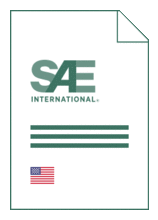Standards Worldwide
Standards Worldwide
Phone +49 30 58885700-07

Standard [CURRENT]
SAE J 1086:2012-10-15
Numbering Metals and Alloys
- Publication date
- 2012-10-15
- Original language
- English
- Pages
- 10
- Publication date
- 2012-10-15
- Original language
- English
- Pages
- 10
Product information on this site:
Quick delivery via download or delivery service
Buy securely with a credit card or pay upon receipt of invoice
All transactions are encrypted
Short description
This document has been declared "Stabilized" and will no longer be subjected to periodic reviews for currency. Users are responsible for verifying references and continued suitability or technical requirements. New technology may exist. This SAE Recommended Practice describes a unified numbering system (UNS) for metals and alloys which have a "commercial standing" and covers the procedure by which such numbers are assigned. Section 2 describes the system of alphanumeric designations or "numbers" established for each family of metals and alloys. Section 3 outlines the organization established for administering the system. Section 4 describes the procedure for requesting number assignment to metals and alloys for which UNS numbers have not previously been assigned. The UNS provides a means of correlating many nationally used numbering systems currently administered by societies, trade associations, and individual users and producers of metals and alloys, thereby avoiding confusion caused by use of more than one identification number for the same material; and by the opposite situation of having the same number assigned to two or more entirely different materials. It provides, also, the uniformity necessary for efficient indexing, record keeping, data storage and retrieval, and cross referencing. A UNS number is not in itself a specification, since it establishes no requirements for form, condition, quality, etc. It is a unified identification of metals and alloys for which controlling limits have been established in specifications published elsewhere.
Loading recommended items...
Loading recommended items...
Loading recommended items...
Loading recommended items...
